Identification of Cotton Defoliation Sensitive Materials Based on UAV Multispectral Imaging
Abstract
1. Introduction
- (1)
- The vegetation indices selected, which are related to cotton defoliation, can serve as evaluation indicators for assessing the effectiveness of cotton defoliation, providing a reference for subsequent research.
- (2)
- A framework for evaluating materials using drone-based multispectral technology has been established, offering theoretical foundations and technical references for selecting cotton germplasm resources with superior defoliation effects suitable for mechanized harvesting.
- (3)
- The effectiveness of cotton defoliation was assessed and selected using drone-based multispectral technology, and a comparison and analysis was conducted with traditional manual screening of cotton materials sensitive to defoliation. The results indicate that the use of drone-mounted vegetation indices for screening is highly consistent with the manual survey and selection methods in identifying defoliation-effective materials. This further enhances the application of drone multispectral technology and vegetation indices in evaluating cotton defoliation sensitivity.
2. Materials and Methods
2.1. Materials and Geographical Location
2.2. Experimental Design and Treatments
2.3. Investigation Contents and Measurement Methods
2.3.1. Field Data Acquisition in Datian
2.3.2. UAV Multispectral Data Acquisition
2.4. Data Processing
2.4.1. Calculation of Defoliation Rate and Boll Opening Rate
2.4.2. Unmanned Aerial Vehicle Data Processing
2.4.3. Vegetation Index
3. Results and Analysis
3.1. Descriptive Statistical Analysis of Phenotypic Traits of 123 Upland Cotton Germplasm Resources
3.2. The Effect of Defoliants on the Defoliation Rate and Boll Opening Rate of Cotton Germplasm Resources
3.3. Screening of Defoliation-Sensitive Varieties Based on Defoliation Rate
3.4. Screening of Defoliation-Sensitive Materials of Cotton Based on Multispectral
3.4.1. Changes in Multispectral Reflectance Values
3.4.2. Analysis of the Correlation Between Multi-Spectral Bands and Vegetation Indexes and Defoliation Rate
3.4.3. PSRI Clustering Screening for Defoliation-Sensitive Upland Cotton Germplasm Resources
3.5. Defoliation Rate Classification and PSRI Classification Screening Materials Consistency Evaluation
4. Discussion
4.1. Defoliation Effect Evaluation
4.2. Comparison Between Traditional Survey Methods and UAV Multispectral Technology
4.3. Discussion on the Application of Multi-Spectral Bands and Vegetation Indices
4.4. Outlook
5. Conclusions
Author Contributions
Funding
Institutional Review Board Statement
Data Availability Statement
Conflicts of Interest
References
- Zhang, Y. The Technological Power Behind Cotton Yield Increase in Xinjiang. China Agricultural Mechanization Herald, 20 February 2025. (In Chinese) [Google Scholar]
- Liang, L. The Technological Code for High Yield of Xinjiang Cotton. Science and Technology Daily, 25 December 2024. (In Chinese) [Google Scholar]
- Tian, R.Y.; Mao, Y.Q.; Jia, W.M. Analysis on Costs and Benefits of Manual and Mechanical Harvesting of Cotton in Xinjiang. Agric. Technol. 2015, 35, 249. (In Chinese) [Google Scholar]
- Li, H.B. Comparative Analysis of Defoliation Effects of Different Formula Defoliants Sprayed on Cotton. Xinjiang Farm. Res. Sci. Technol. 2013, 36, 39–40. (In Chinese) [Google Scholar]
- Xiang, B. Application Research of Low-altitude Remote Sensing Images from UAVs. Low Carbon World 2017, 89–90. (In Chinese) [Google Scholar]
- Haldar, D.; Dave, V.; Misra, A.; Bhattacharya, B. Radar Vegetation Index for assessing cotton crop condition using RISAT-1 data. Geocarto Int. 2020, 35, 364–375. [Google Scholar] [CrossRef]
- Xie, Q.; Dash, J.; Huete, A.; Jiang, A.; Yin, G.; Ding, Y.; Peng, D.; Hall, C.C.; Brown, L.; Shi, Y.; et al. Retrieval of crop biophysical parameters from Sentinel-2 remote sensing imagery. Int. J. Appl. Earth Obs. Geoinf. 2019, 80, 187–195. [Google Scholar] [CrossRef]
- Ma, Y. Estimation of Water and Nitrogen Parameters in Cotton Canopy Based on Hyperspectral Remote Sensing. Master’s Thesis, Chinese Academy of Agricultural Sciences, Beijing, China, 2020. (In Chinese). [Google Scholar]
- Junker, L.V.; Ensminger, I. Relationship between leaf optical properties, chlorophyll fluorescence and pigment changes in senescing Acer saccharum leaves. Tree Physiol. 2016, 36, 694–711. [Google Scholar] [CrossRef]
- Zhang, L.; Sun, B.; Zhao, D.; Shan, C.; Wang, G.; Song, C.; Chen, P.; Lan, Y. Prediction of cotton FPAR and construction of defoliation spraying prescription map based on multi-source UAV images. Comput. Electron. Agric. 2024, 220, 108897. [Google Scholar] [CrossRef]
- Liang, F.R.; Long, Y.L.; Du, X.; Tan, Y.; Tao, Z.; Li, L.; Ye, P.; Kurban, W.; Ai, X. Research Progress on Cotton Defoliation and Ripening Agents and Their Application Technologies. China Cotton 2024, 51, 1–7. (In Chinese) [Google Scholar]
- Chen, B.; Zhang, G.; Wang, J.; Liu, J.; Li, S.; Yu, Y.; Wang, F.; Han, H. Effect of Different Defoliants on Machine—Picked Cotton under Equal spacing and Dense Planting Model. J. Acta Agric. Boreali-Occident. Sin. 2019, 28, 1594–1601. (In Chinese) [Google Scholar]
- Maes, W.H.; Steppe, K. Perspectives for remote sensing with unmanned aerial vehicles in precision agriculture. Trends Plant Sci. 2019, 24, 152–164. [Google Scholar] [CrossRef]
- Yan, C.Y.; Li, W.H.; Lan, Y.B.; Hu, C.; Lu, L.; Zhao, J. Monitoring Cotton Defoliation Effects and Prescription Map Generation Based on UAV Multispectral Remote Sensing. J. Nanjing Agric. Univ. 2022, 45, 799–808. (In Chinese) [Google Scholar]
- Ma, Y.; Lü, X.; Qi, Y.; Zhang, Z.; Yi, X.; Chen, X.; Yan, T.; Hou, T. Construction of a Monitoring Model for Defoliation Rate of Machine-Harvested Cotton Based on UAV Digital Images. Cotton Sci. 2021, 33, 347–359. (In Chinese) [Google Scholar]
- Ma, Y.; Chen, X.; Huang, C.; Hou, T.; Lv, X.; Zhang, Z. Monitoring defoliation rate and boll-opening rate of machine-harvested cotton based on UAV RGB images. Eur. J. Agron. 2023, 151, 126976. [Google Scholar] [CrossRef]
- Du, X.M.; Zhou, Z.L. Descriptive Specifications and Data Standards for Cotton Germplasm Resources; China Agriculture Press: Beijing, China, 2005. (In Chinese) [Google Scholar]
- Rouse J., W.; Haas, R.H.; Deering, D.W.; Schell, J.A.; Harlan, J.C. Monitoring the Vernal Advancement and Retrogradation (Green Wave Effect) of Natural Vegetation NASA/GSFC Type III Final Report; NASA: Greenbelt, MD, USA, 1974.
- Daughtry, C.; Gallo, K.; Goward, S.; Prince, S.; Kustas, W. Spectral estimates of absorbed radiation and phytomass production in corn and soybean canopies. Remote Sens. Environ. 1992, 39, 141–152. [Google Scholar] [CrossRef]
- Pearson, R.L.; Miller, L.D. Remote mapping of standing crop biomass for estimation of the productivity of the shortgrass prairie, Pawnee National Grasslands, Colorado. In Proceedings of the Eighth International Symposium on Remote Sensing of Environment, Ann Arbor, MI, USA, 2–6 October 1972. [Google Scholar]
- Huete, A.R. A soil-adjusted vegetation index (SAVI). Remote Sens. Environ. 1988, 25, 295–309. [Google Scholar] [CrossRef]
- Miura, T.; Huete, A.R.; Yoshioka, H. Evaluation of sensor calibration uncertainties on vegetation indices for MODIS. IEEE Trans. Geosci. Remote Sens. 2000, 38, 1399–1409. [Google Scholar] [CrossRef]
- Meyer, G.E.; Neto, J.C. Verification of color vegetation indices for automated crop imaging applications. Comput. Electron. Agric. 2008, 63, 282–293. [Google Scholar] [CrossRef]
- Daughtry, C.S.T.; Walthall, C.L.; Kim, M.S.; De Colstoun, E.B.; McMurtrey, J.E., III. Estimating corn leaf chlorophyll concentration from leaf and canopy reflectance. Remote Sens. Environ. 2000, 74, 229–239. [Google Scholar] [CrossRef]
- Chen, J.M.; Cihlar, J. Retrieving leaf area index of boreal conifer forests using Landsat TM images. Remote Sens. Environ. 1996, 55, 153–162. [Google Scholar] [CrossRef]
- Jin, Y.E.; Liu, C.S.; Zhang, W.Z. A Method of Calculating Surface Moisturefrom GMS and AVHRR. J. Appl. Meteorol. Sci. 1998, 9, 70–77. (In Chinese) [Google Scholar]
- Penuelas, J.; Baret, F.; Filella, I. Semi-empirical indices to assess carotenoids/chlorophyll a ratio from leaf spectral reflectance. Photosynthetica 1995, 31, 221–230. [Google Scholar]
- Merzlyak, M.N.; Gitelson, A.A.; Chivkunova, O.B.; Rakitin, V.Y. Non-destructive optical detection of pigment changes during leaf senescence and fruit ripening. Physiol. Plant. 1999, 106, 135–141. [Google Scholar] [CrossRef]
- Chen, B.B.; Li, P.; Li, Z.Y.; Xiao, H.B.; Dong, H.Q. Screening of Defoliant Formulas for Machine-Picked Cotton Fields in Southern Xinjiang. J. Tarim. Univ. 2017, 29, 64–69. (In Chinese) [Google Scholar]
- Gao, L.L.; Li, G.; Xu, X.X.; Zheng, H.; Zhang, J. Comparative Study on Defoliation Efficacy of Four Cotton Defoliants. J. Xinjiang Agric. Univ. 2016, 39, 35–39. (In Chinese) [Google Scholar]
- Zhuang, J.Y.; Bao, W.J.; Su, W.Z. Current Status and Prospects of Agricultural Remote Sensing Applications. Agric. Outlook 2024, 20, 68–74. (In Chinese) [Google Scholar]
- Cozzolino, D.; Fassio, A.; Gimenez, A. The use of near-infrared reflectance spectroscopy (NIRS) to predict the composition of whole maize plants. J. Sci. Food Agric. 2001, 81, 142–146. [Google Scholar] [CrossRef]
- Serrano, L.; Filella, I.; Peñuelas, J. Remote sensing of biomass and yield of winter wheat under different nitrogen supplies. Crop Sci. 2000, 40, 723–731. [Google Scholar] [CrossRef]
- Tewes, A.; Schellberg, J. Towards remote estimation of radiation use efficiency in maize using UAV-based low-cost camera imagery. Agronomy 2018, 8, 16. [Google Scholar] [CrossRef]
- Olson, D.; Anderson, J. Review on unmanned aerial vehicles, remote sensors, imagery processing, and their applications in agriculture. Agron. J. 2021, 113, 971–992. [Google Scholar] [CrossRef]
- Song, P.; Wang, J.; Guo, X.; Yang, W.; Zhao, C. High-throughput phenotyping: Breaking through the bottleneck in future crop breeding. Crop J. 2021, 9, 633–645. [Google Scholar] [CrossRef]
- Wang, Y.; Xiao, C.; Wang, Y.; Li, K.; Yu, K.; Geng, J.; Li, Q.; Yang, J.; Zhang, J.; Zhang, M.; et al. Monitoring of Cotton Boll Opening Rate Based on UAV Multispectral Data. Remote Sens. 2024, 16, 132. [Google Scholar] [CrossRef]
- Yi, Q.X. Estimation of Cotton Leaf Area Index Based on Sentinel-2 Multispectral Data. Trans. Chin. Soc. Agric. Eng. 2019, 35, 189–197, (In Chinese with English Abstract). [Google Scholar]
- Li, Y.B.; Mao, S.C.; Wang, X.H.; Han, Y.C.; Liu, W.; Wang, G.P.; Fan, Z.Y. Study on Digital Imaging Indices for Diagnosing Cotton Premature Senescence Severity. Cotton Sci. 2006, 160–163. (In Chinese) [Google Scholar]
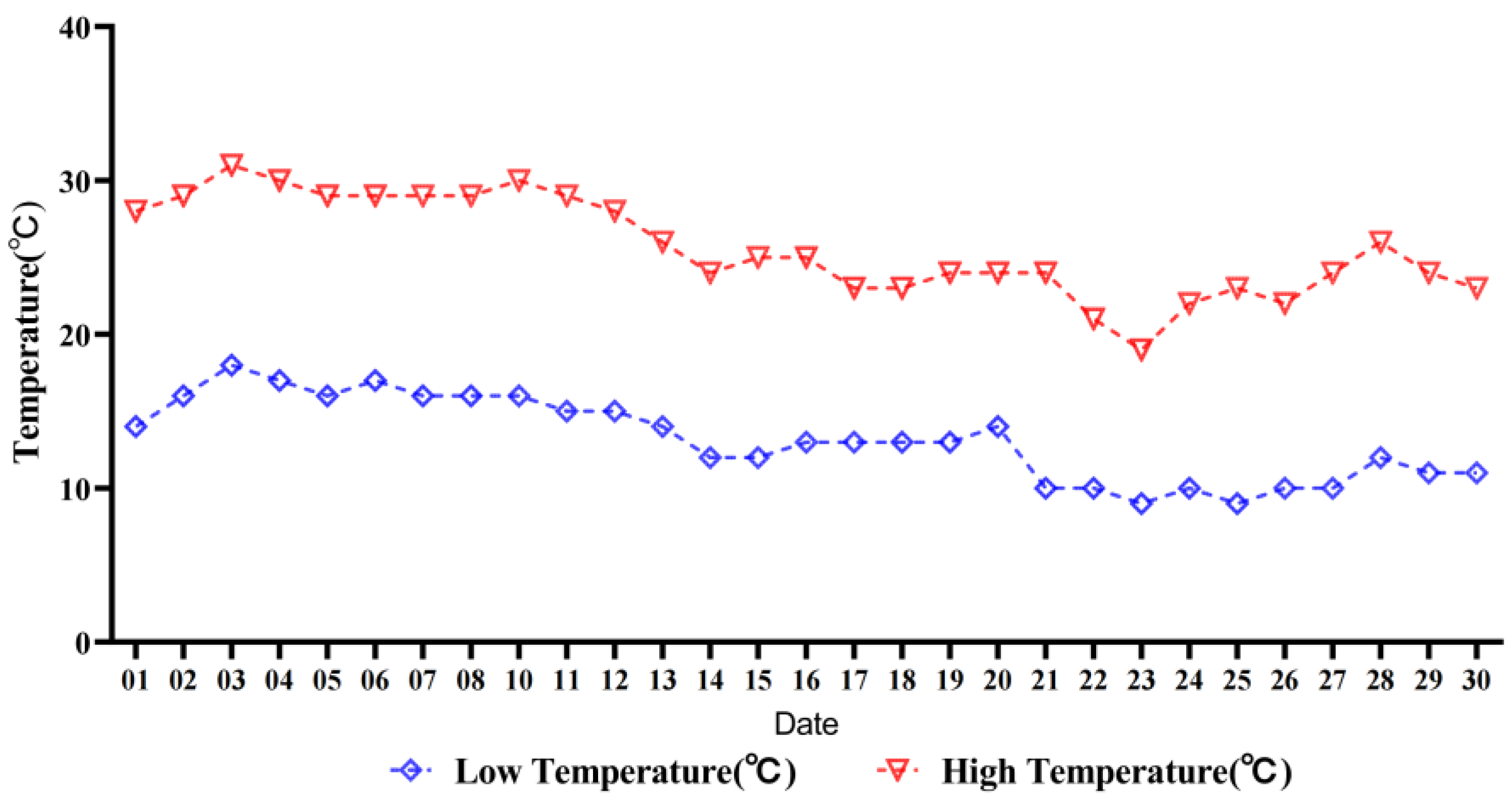
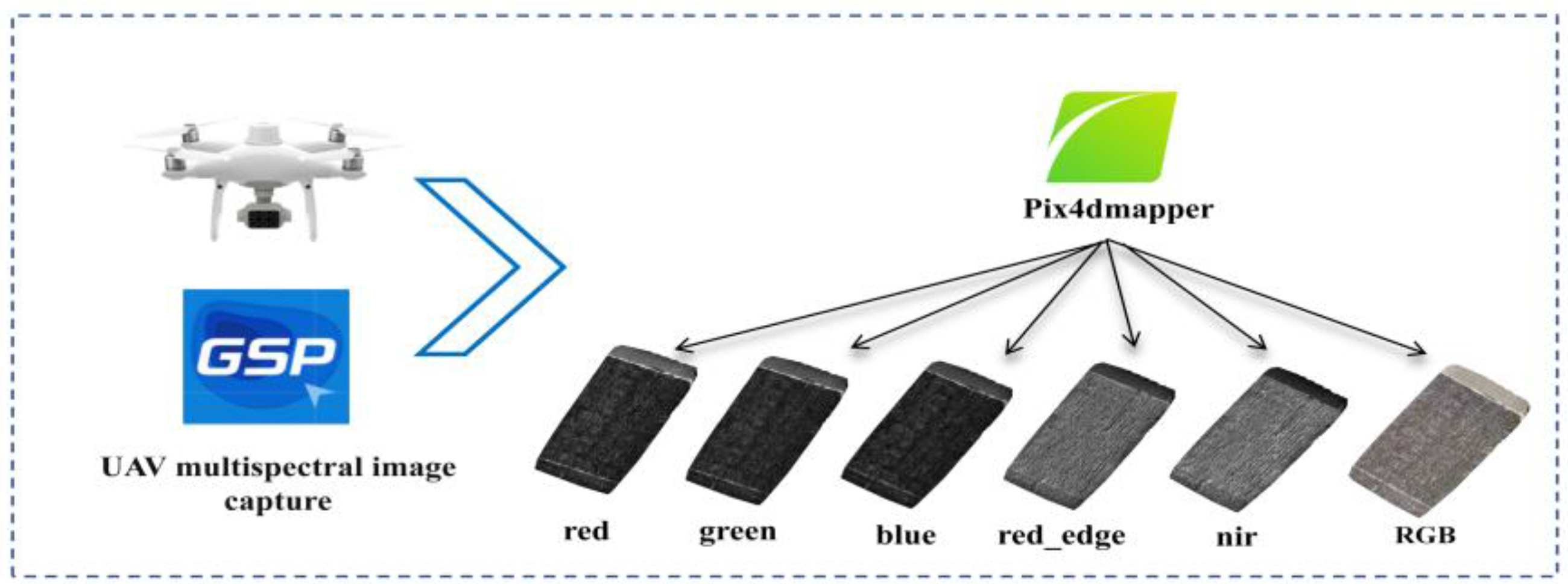

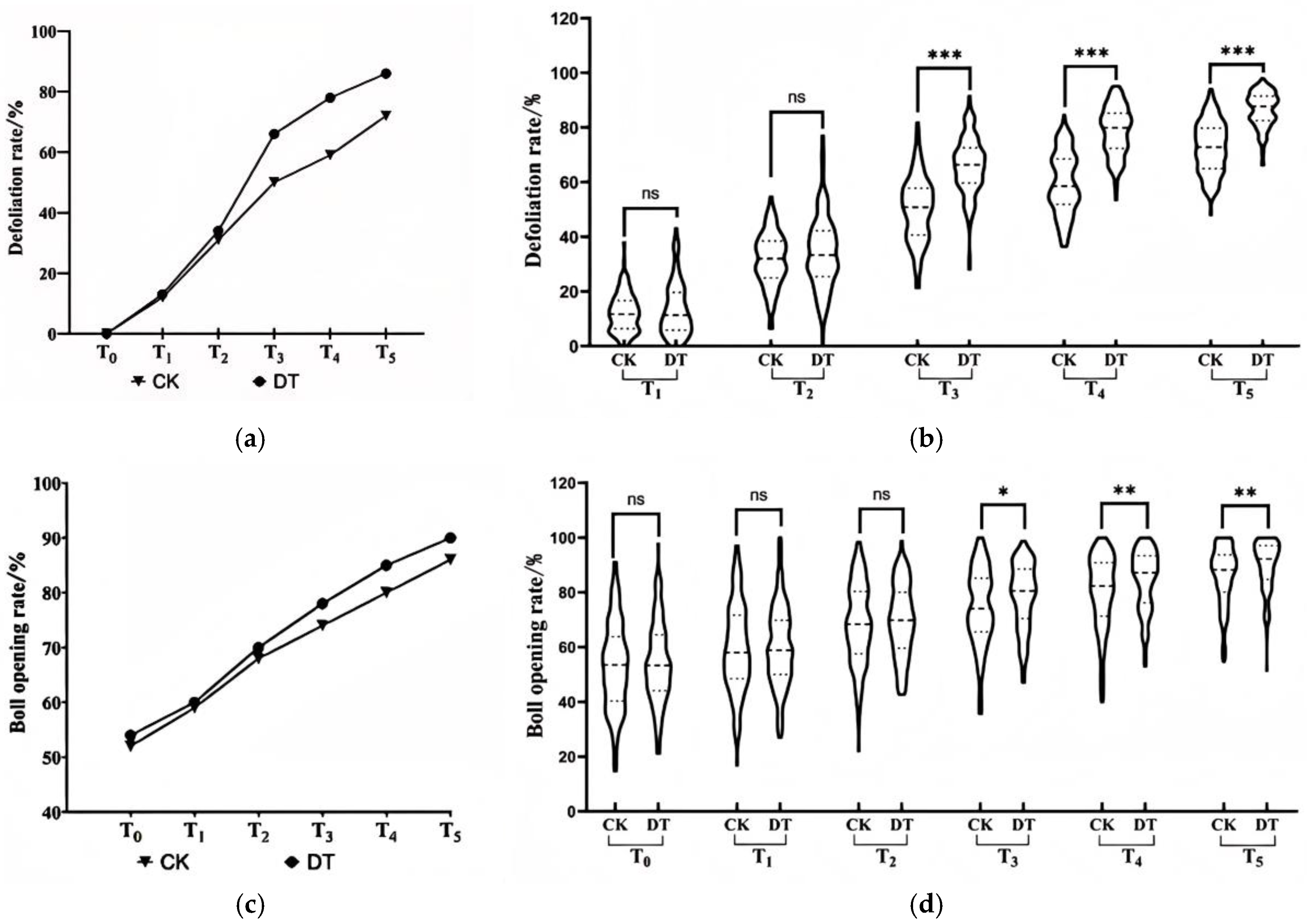
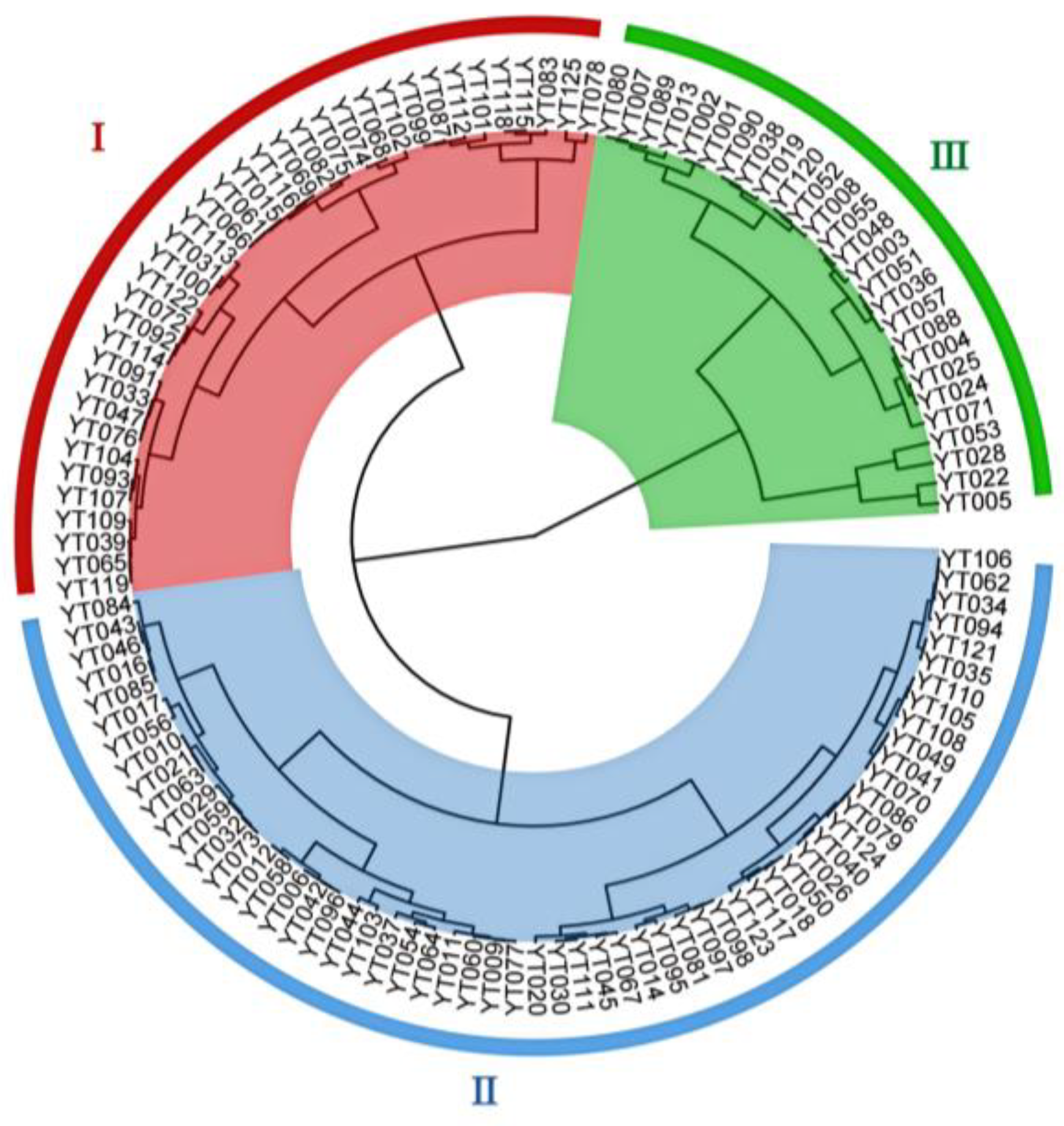
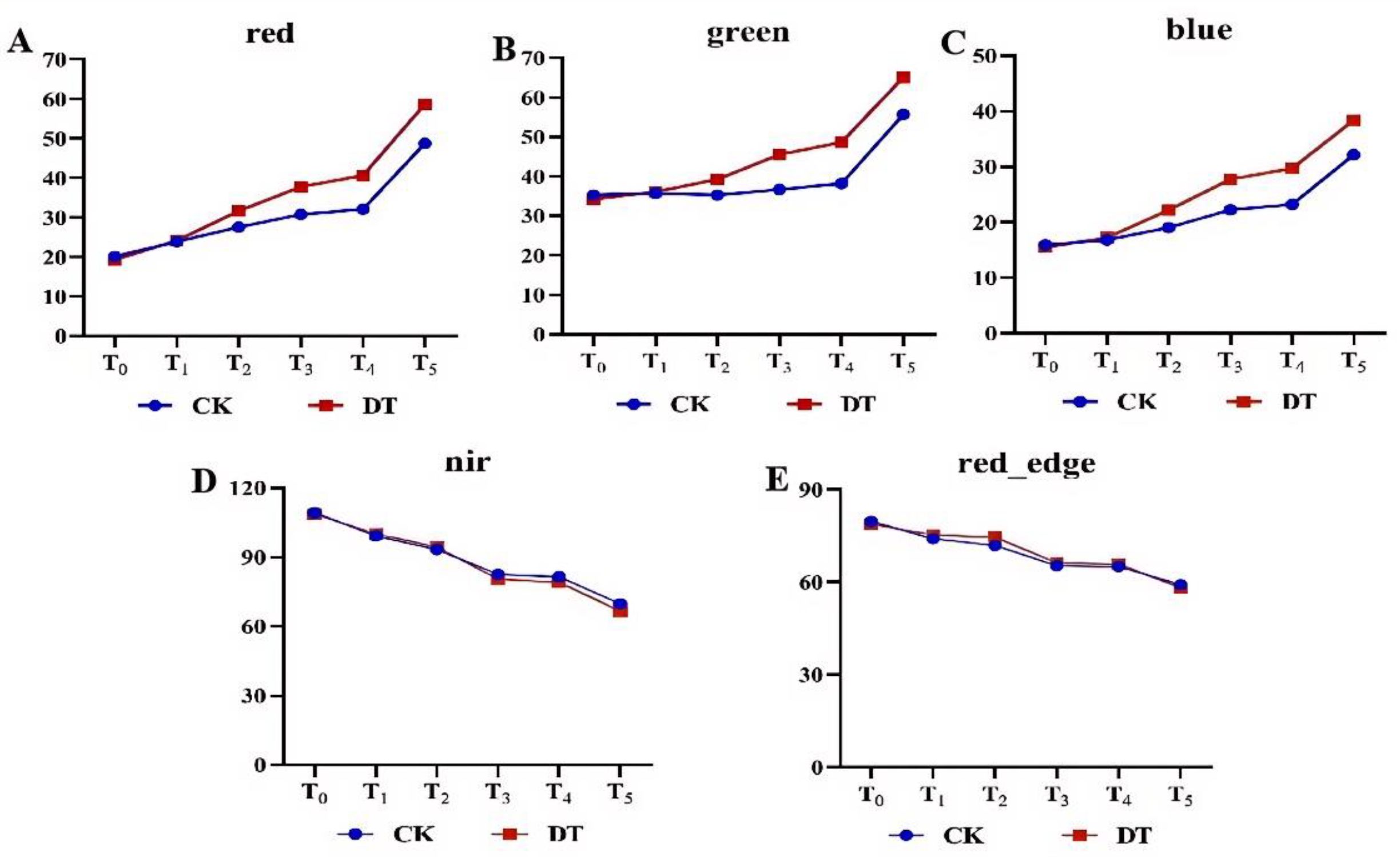
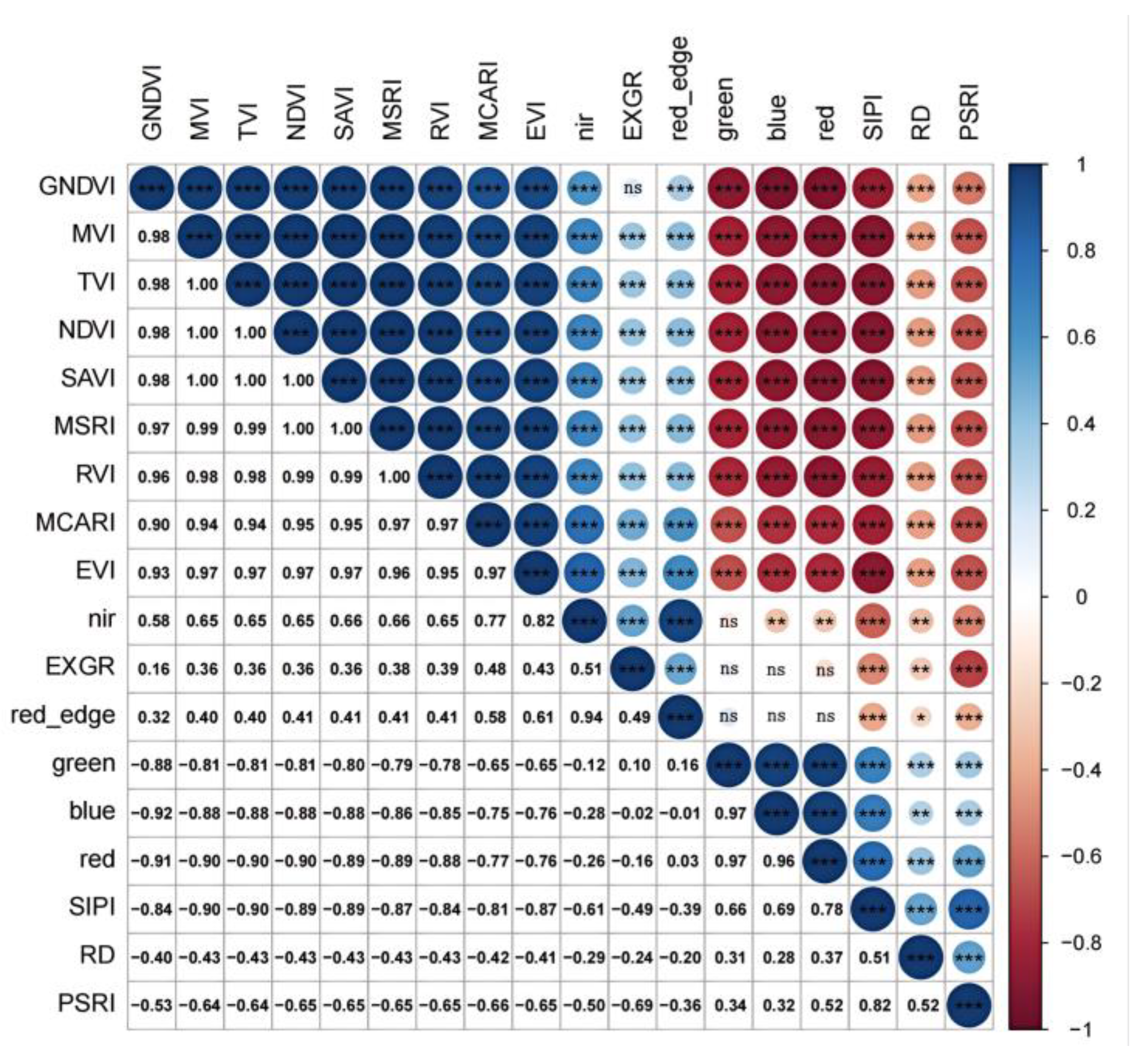
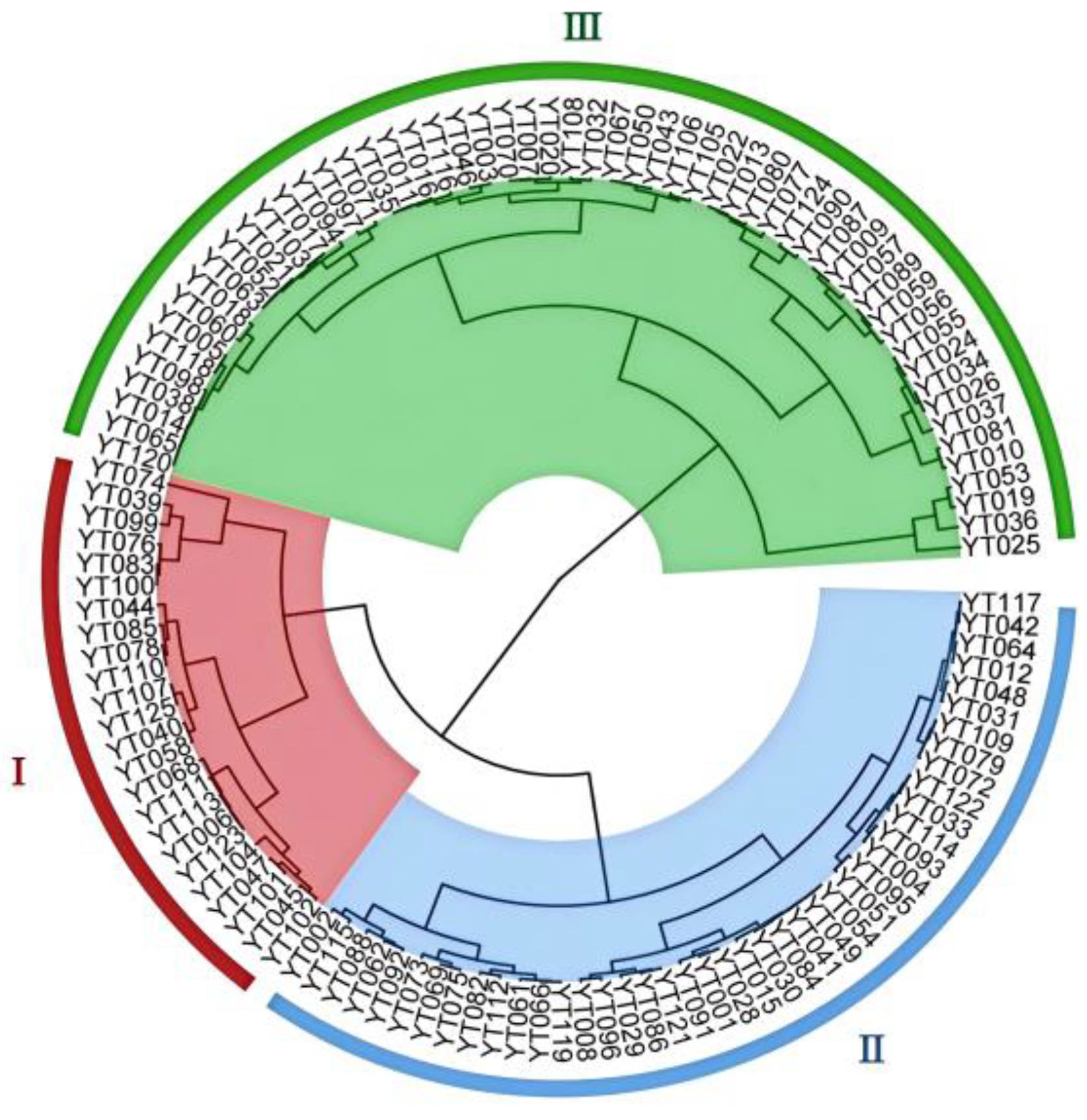
| No. | Name | Source | No. | Name | Source | No. | Name | Source | No. | Name | Source | No. | Name | Source |
|---|---|---|---|---|---|---|---|---|---|---|---|---|---|---|
| YT001 | Liaomian 25 | The Yellow River Basin | YT028 | Xinluzao 74 | Northwest Inland | YT053 | Ari971 | Abroad | YT078 | Simian 2 | The Yangtze River Basin | YT103 | Source Cotton 8 | Northwest Inland |
| YT002 | Liaomian 35 | The Yellow River Basin | YT029 | Xinluzao 75 | Northwest Inland | YT054 | BP52 | Abroad | YT079 | Simian 3 | The Yangtze River Basin | YT104 | J206-5 | Northwest Inland |
| YT003 | Shengmian 6 | Other Sources | YT030 | Xinluzao 76 | Northwest Inland | YT055 | Si-1470 | Abroad | YT080 | Xinluzao 42 | Northwest Inland | YT105 | Guanmian 678 | Self-bred Promotion |
| YT004 | Xinmian 3 | Northwest Inland | YT031 | Xinluzao 78 | Northwest Inland | YT056 | J02-247 | The Yangtze River Basin | YT081 | Xinluzao 33 | Northwest Inland | YT106 | Baijin 3045 | Self-bred Promotion |
| YT005 | Xinshi K18 | Northwest Inland | YT032 | Xinluzao 79 | Northwest Inland | YT057 | Z37less | Abroad | YT082 | Xinluzao 23 | Northwest Inland | YT107 | Guanmian 614 | Self-bred Promotion |
| YT006 | Xinshi K24 | Northwest Inland | YT033 | Xinluzao 84 | Northwest Inland | YT058 | Bamian 1 | The Yangtze River Basin | YT083 | Xinluzao 10 | Northwest Inland | YT108 | Kang 41 | Self-bred Promotion |
| YT007 | Chuangmian 512 | The Yellow River Basin | YT034 | Xinluzhong 38 | Northwest Inland | YT059 | Changkangmian | The Yangtze River Basin | YT084 | Xinluzao 8 | Northwest Inland | YT109 | Feng Haimian | Self-bred Promotion |
| YT008 | Longmian 10 | Northwest Inland | YT035 | Xinluzhong 50 | Northwest Inland | YT060 | Chuan 169-6 | The Yangtze River Basin | YT085 | Tu 83-161 | Northwest Inland | YT110 | Fengze 7 | Self-bred Promotion |
| YT009 | Jinken 1441 | Northwest Inland | YT036 | Mutant1 | Self-bred Materials | YT061 | Jingzhou Degenerated Cotton | The Yangtze River Basin | YT086 | Xinluzao 47 | Northwest Inland | YT111 | Huimin 52 | Self-bred Promotion |
| YT010 | Jinken 1565 | Northwest Inland | YT037 | Mutant2 | Self-bred Materials | YT062 | Jing 55173 | The Yellow River Basin | YT087 | Xinluzao 48 | Northwest Inland | YT112 | Huimin 4 | Self-bred Promotion |
| YT011 | Jinken 1643 | Northwest Inland | YT038 | Mutant3 | Self-bred Materials | YT063 | Jinmian 36 | The Yellow River Basin | YT088 | Xinluzao 49 | Northwest Inland | YT113 | Guanmian V5 | Self-bred Promotion |
| YT012 | Jiumian NE01 | Other Sources | YT039 | Mutant4 | Self-bred Materials | YT064 | Jinzimian King | Abroad | YT089 | Xinluzao 52 | Northwest Inland | YT114 | Genesis 8 | Self-bred Promotion |
| YT013 | W8225 | The Yellow River Basin | YT040 | Mutant5 | Self-bred Materials | YT065 | Jiangsu Cotton 1 | The Yangtze River Basin | YT090 | Xinluzao 61 | Northwest Inland | YT115 | Hexin Seed Industry 14 | Self-bred Promotion |
| YT014 | Xinniumian 206 | Other Sources | YT041 | Mutant6 | Self-bred Materials | YT066 | Jimian 8 | The Yellow River Basin | YT091 | Xinluzhong 6 | Northwest Inland | YT116 | Guanmian 648 | Self-bred Promotion |
| YT015 | Zhongmiansuo 115 | The Yellow River Basin | YT042 | Mutant7 | Self-bred Materials | YT067 | Jijiaohongye Mian | Abroad | YT092 | Xinluzhong 14 | Northwest Inland | YT117 | Genesis 5 | Self-bred Promotion |
| YT016 | Xinluzao 27 | Northwest Inland | YT043 | Mutant8 | Self-bred Materials | YT068 | Han 241 | The Yellow River Basin | YT093 | Xinluzhong 36 | Northwest Inland | YT118 | Zhongya Huijin 6 | Self-bred Promotion |
| YT017 | Xinluzao 50 | Northwest Inland | YT044 | Mutant9 | Self-bred Materials | YT069 | Ganmian 12 | The Yangtze River Basin | YT094 | Xinluzhong 41 | Northwest Inland | YT119 | Fengdekang 4 | Self-bred Promotion |
| YT018 | Xinluzao 51 | Northwest Inland | YT045 | Mutant10 | Self-bred Materials | YT070 | Ferganskaya 175 | Abroad | YT095 | Xinluzhong 54 | Northwest Inland | YT120 | Genesis 7 | Self-bred Promotion |
| YT019 | Xinluzao 54 | Northwest Inland | YT046 | R22-46 | Self-bred Materials | YT071 | Miaohua in Judian Township, Lijiang County, Yunnan | The Yangtze River Basin | YT096 | Zhongmiansuo 17 | The Yellow River Basin | YT121 | Genesis 8 | Self-bred Promotion |
| YT020 | Xinluzao 55 | Northwest Inland | YT047 | Xinluzao 11 | Northwest Inland | YT072 | Daihongdai | The Yangtze River Basin | YT097 | Zhongmiansuo 12 | The Yellow River Basin | YT122 | Genesis 3 | Self-bred Promotion |
| YT021 | Xinluzao 57 | Northwest Inland | YT048 | Zhongmian Institute 43 | The Yellow River Basin | YT073 | Kuche 96515 | Northwest Inland | YT098 | Zhong 203016 | The Yellow River Basin | YT123 | Xiangsui Seed Industry 2 | Self-bred Promotion |
| YT022 | Xinluzao 60 | Northwest Inland | YT049 | 70-1437 | The Yangtze River Basin | YT074 | Liaomian 9 | The Yellow River Basin | YT099 | Yuan 247-31 | The Yellow River Basin | YT124 | Jike Huayu 1 | Self-bred Promotion |
| YT024 | Xinluzao 64 | Northwest Inland | YT050 | 73-184 | The Yellow River Basin | YT075 | Zhongmiansuo 23 | The Yellow River Basin | YT100 | Yumian 1 | The Yellow River Basin | YT125 | Xinluzao 73 | Northwest Inland |
| YT025 | Xinluzao 68 | Northwest Inland | YT051 | AC321 | Abroad | YT076 | Shaan 416 | The Yellow River Basin | YT101 | Xinluzhong 68 | Northwest Inland | |||
| YT026 | Xinluzao 69 | Northwest Inland | YT052 | Ari3697 | The Yellow River Basin | YT077 | Shen 547 | The Yangtze River Basin | YT102 | Xinluzhong 75 | Northwest Inland |
| Band | Central Wavelength (nm) | Bandwidth (nm) |
|---|---|---|
| blue | 450 | 16 |
| green | 560 | 16 |
| red | 650 | 16 |
| red_edge | 730 | 16 |
| nir | 840 | 26 |
| No. | Vegetation Index | Abbreviation | Formula | Source |
|---|---|---|---|---|
| 1 | Normalized Difference Vegetation Index | NDVI | [18] | |
| 2 | Normalized Green Difference Vegetation Index | GNDVI | [19] | |
| 3 | Transformed Vegetation Index | TVI | [18] | |
| 4 | Ratio Vegetation Index | RVI | [20] | |
| 5 | Soil-Adjusted Vegetation Index | SAVI | [21] | |
| 6 | Enhanced Vegetation Index | EVI | [22] | |
| 7 | Excess Green Minus Red | EXGR | [23] | |
| 8 | Modified Chlorophyll Absorption Reflectance Index | MCARI | [24] | |
| 9 | Modified second ratio index | MSRI | [25] | |
| 10 | Moisture Vegetation Index | MVI | [26] | |
| 11 | Structure Independent Pigment Index | SIPI | [27] | |
| 12 | Plant Senescence Reflectance Index | PSRI | [28] |
| Traits | Average | Standard Deviation | Min | Max | Coefficient of Variation (%) |
|---|---|---|---|---|---|
| Plant height (cm) | 87.30 | 9.64 | 59.20 | 120.80 | 11.04 |
| Height of the first fruiting branch (cm) | 20.41 | 4.70 | 5.80 | 38.00 | 23.00 |
| Number of fruiting branches | 10.17 | 1.19 | 5.80 | 13.75 | 11.66 |
| Number of effective fruiting branches | 6.58 | 1.15 | 3.60 | 12.00 | 17.47 |
| Number of bolls per plant | 8.19 | 1.65 | 4.80 | 14.20 | 20.16 |
| No. | Material Name | Defoliation Rate (%) | Lint Percentage (%) | No. | Material Name | Defoliation Rate (%) | Lint Percentage (%) |
|---|---|---|---|---|---|---|---|
| YT015 | Zhongmiansuo 115 | 84.76 | 89.29 | YT092 | Xinluzhong 14 | 89.36 | 61.84 |
| YT031 | Xinluzao 78 | 90.59 | 86.60 | YT093 | Xinluzhong 36 | 88.32 | 88.31 |
| YT033 | Xinluzao 84 | 87.35 | 88.24 | YT099 | Yuan 247-31 | 92.57 | 94.20 |
| YT039 | Mutant 4 | 88.03 | 78.48 | YT100 | Yumian 1 | 90.48 | 84.88 |
| YT047 | Xinluzao 11 | 87.41 | 91.43 | YT101 | Xinluzhong 68 | 92.15 | 87.04 |
| YT061 | Jingzhou Degenerated Cotton | 84.80 | 90.00 | YT102 | Xinluzhong 75 | 86.52 | 88.00 |
| YT065 | Jiangsu Cotton 1 | 88.10 | 75.29 | YT104 | J206-5 | 88.56 | 91.86 |
| YT066 | Jimian 8 | 84.82 | 95.35 | YT107 | Guomian 614 | 88.31 | 94.20 |
| YT068 | Han 241 | 85.81 | 86.32 | YT109 | Fenghaimian | 87.91 | 86.25 |
| YT069 | Ganmian 12 | 84.92 | 81.36 | YT112 | Huimin 4 | 92.82 | 96.59 |
| YT072 | Daihongdai | 89.17 | 77.17 | YT113 | Guamian V5 | 90.97 | 88.06 |
| YT074 | Liaomian 9 | 85.95 | 97.08 | YT114 | Genesis 8 | 89.47 | 96.15 |
| YT075 | Zhongmiansuo 23 | 85.16 | 80.85 | YT115 | Hexin Seed Industry 14 | 93.08 | 93.42 |
| YT076 | Shan 416 | 87.43 | 76.67 | YT116 | Guanmian 648 | 84.95 | 95.51 |
| YT078 | Simian 2 | 95.12 | 82.72 | YT118 | Zhongya Huijin 6 | 93.05 | 97.89 |
| YT082 | Xinluzao 23 | 85.28 | 91.57 | YT119 | Fengdekang 4 | 88.11 | 100.00 |
| YT083 | Xinluzao 10 | 93.43 | 93.24 | YT122 | Genesis 3 | 89.73 | 90.65 |
| YT087 | Xinluzao 48 | 92.67 | 81.91 | YT125 | Xinluzao 73 | 94.23 | 98.04 |
| YT091 | Xinluzhong 6 | 87.57 | 89.81 |
| No. | Material Name | Defoliation Rate (%) | Lint Percentage (%) | PSRI | No. | Material Name | Defoliation Rate (%) | Lint Percentage (%) | PSRI |
|---|---|---|---|---|---|---|---|---|---|
| YT006 | New Stone K24 | 75.34 | 84.54 | 0.1696 | YT085 | Tu 83-161 | 72.49 | 92.31 | 0.1640 |
| YT039 | Mutant4 | 88.03 | 78.48 | 0.1795 | YT099 | Yuan 247-31 | 92.57 | 94.20 | 0.1819 |
| YT040 | Mutant5 | 83.23 | 73.42 | 0.1628 | YT100 | Yumian 1 | 90.48 | 84.88 | 0.1852 |
| YT044 | Mutant9 | 78.34 | 70.83 | 0.1662 | YT101 | Xinluzhong 68 | 92.15 | 87.04 | 0.1723 |
| YT045 | Mutant10 | 79.51 | 58.46 | 0.1738 | YT102 | Xinluzhong 75 | 86.52 | 88.00 | 0.1733 |
| YT047 | Xinluzao 11 | 87.41 | 91.43 | 0.1720 | YT104 | J206-5 | 88.56 | 91.86 | 0.1756 |
| YT058 | Bamian 1 | 75.76 | 95.10 | 0.1632 | YT107 | Guanmian 614 | 88.31 | 94.20 | 0.1607 |
| YT068 | Han 241 | 85.81 | 86.32 | 0.1690 | YT110 | Fengze 7 | 82.46 | 96.15 | 0.1650 |
| YT074 | Liaomian 9 | 85.95 | 97.08 | 0.1984 | YT111 | Huimin 52 | 79.37 | 98.57 | 0.1700 |
| YT076 | Shan 416 | 87.43 | 76.67 | 0.1859 | YT113 | Guanmian V5 | 90.97 | 88.06 | 0.1694 |
| YT078 | Simian 2 | 95.12 | 82.72 | 0.1649 | YT123 | Xiangsui Seed Industry 2 | 83.62 | 95.89 | 0.1697 |
| YT083 | Xinluzao 10 | 93.43 | 93.24 | 0.1852 | YT125 | Xinluzao 73 | 94.23 | 98.04 | 0.1609 |
| No. | Material Name | Defoliation Rate (%) | Lint Percentage (%) | PSRI | No. | Material Name | Defoliation Rate (%) | Lint Percentage (%) | PSRI |
|---|---|---|---|---|---|---|---|---|---|
| YT039 | Mutant4 | 88.03 | 78.48 | 0.1795 | YT100 | Yumian 1 | 90.48 | 84.88 | 0.1852 |
| YT047 | Xinluzao 11 | 87.41 | 91.43 | 0.1720 | YT101 | Xinluzhong 68 | 92.15 | 87.04 | 0.1723 |
| YT068 | Han 241 | 85.81 | 86.32 | 0.1690 | YT102 | Xinluzhong 75 | 86.52 | 88.00 | 0.1733 |
| YT074 | Liaomian 9 | 85.95 | 97.08 | 0.1984 | YT104 | J206-5 | 88.56 | 91.86 | 0.1756 |
| YT076 | Shaan 416 | 87.43 | 76.67 | 0.1859 | YT107 | Guanmian 614 | 88.31 | 94.20 | 0.1607 |
| YT078 | Simian 2 | 95.12 | 82.72 | 0.1649 | YT113 | Guanmian V5 | 90.97 | 88.06 | 0.1694 |
| YT083 | Xinluzao 10 | 93.43 | 93.24 | 0.1852 | YT125 | Xinluzao 73 | 94.23 | 98.04 | 0.1609 |
| YT099 | Yuan 247-31 | 92.57 | 94.20 | 0.1819 |
Disclaimer/Publisher’s Note: The statements, opinions and data contained in all publications are solely those of the individual author(s) and contributor(s) and not of MDPI and/or the editor(s). MDPI and/or the editor(s) disclaim responsibility for any injury to people or property resulting from any ideas, methods, instructions or products referred to in the content. |
© 2025 by the authors. Licensee MDPI, Basel, Switzerland. This article is an open access article distributed under the terms and conditions of the Creative Commons Attribution (CC BY) license (https://creativecommons.org/licenses/by/4.0/).
Share and Cite
Guo, Y.; Zhang, H.; Gao, W.; Chen, Q.; Chang, Q.; Wang, J.; Zeng, Q.; Xu, H.; Chen, Q. Identification of Cotton Defoliation Sensitive Materials Based on UAV Multispectral Imaging. Agriculture 2025, 15, 965. https://doi.org/10.3390/agriculture15090965
Guo Y, Zhang H, Gao W, Chen Q, Chang Q, Wang J, Zeng Q, Xu H, Chen Q. Identification of Cotton Defoliation Sensitive Materials Based on UAV Multispectral Imaging. Agriculture. 2025; 15(9):965. https://doi.org/10.3390/agriculture15090965
Chicago/Turabian StyleGuo, Yuantao, Hu Zhang, Wenju Gao, Quanjia Chen, Qiyu Chang, Jinsheng Wang, Qingtao Zeng, Haijiang Xu, and Qin Chen. 2025. "Identification of Cotton Defoliation Sensitive Materials Based on UAV Multispectral Imaging" Agriculture 15, no. 9: 965. https://doi.org/10.3390/agriculture15090965
APA StyleGuo, Y., Zhang, H., Gao, W., Chen, Q., Chang, Q., Wang, J., Zeng, Q., Xu, H., & Chen, Q. (2025). Identification of Cotton Defoliation Sensitive Materials Based on UAV Multispectral Imaging. Agriculture, 15(9), 965. https://doi.org/10.3390/agriculture15090965






